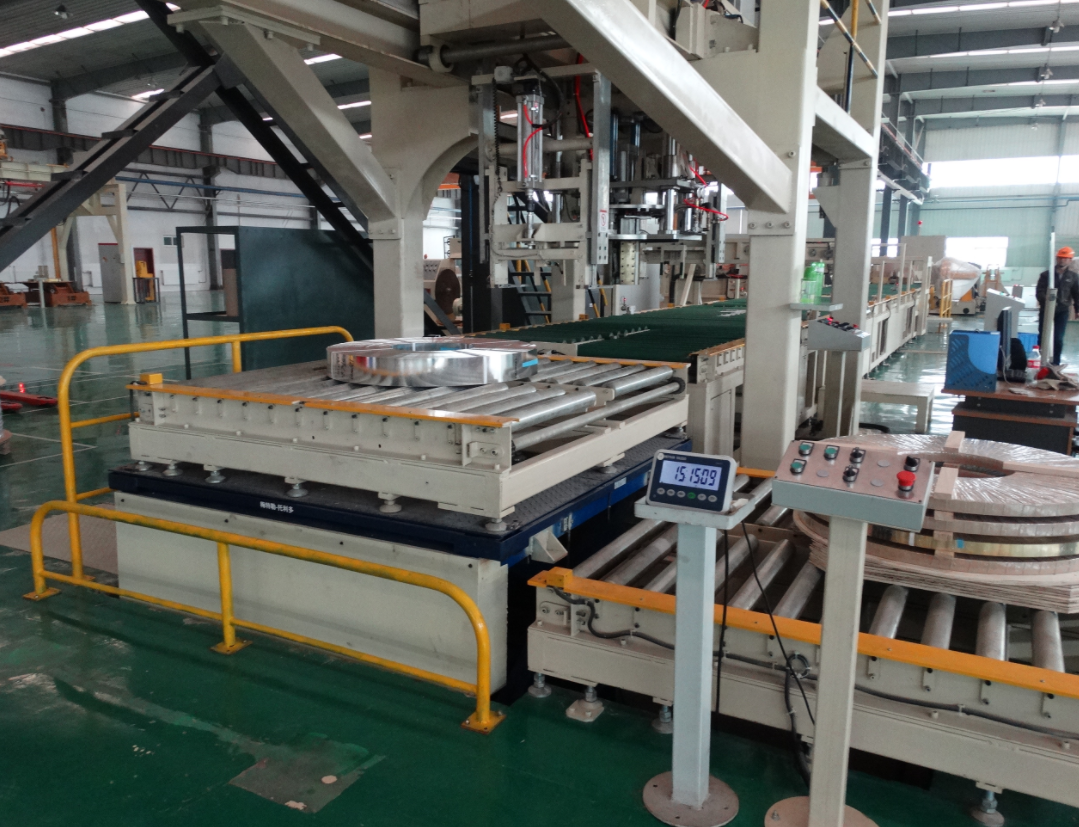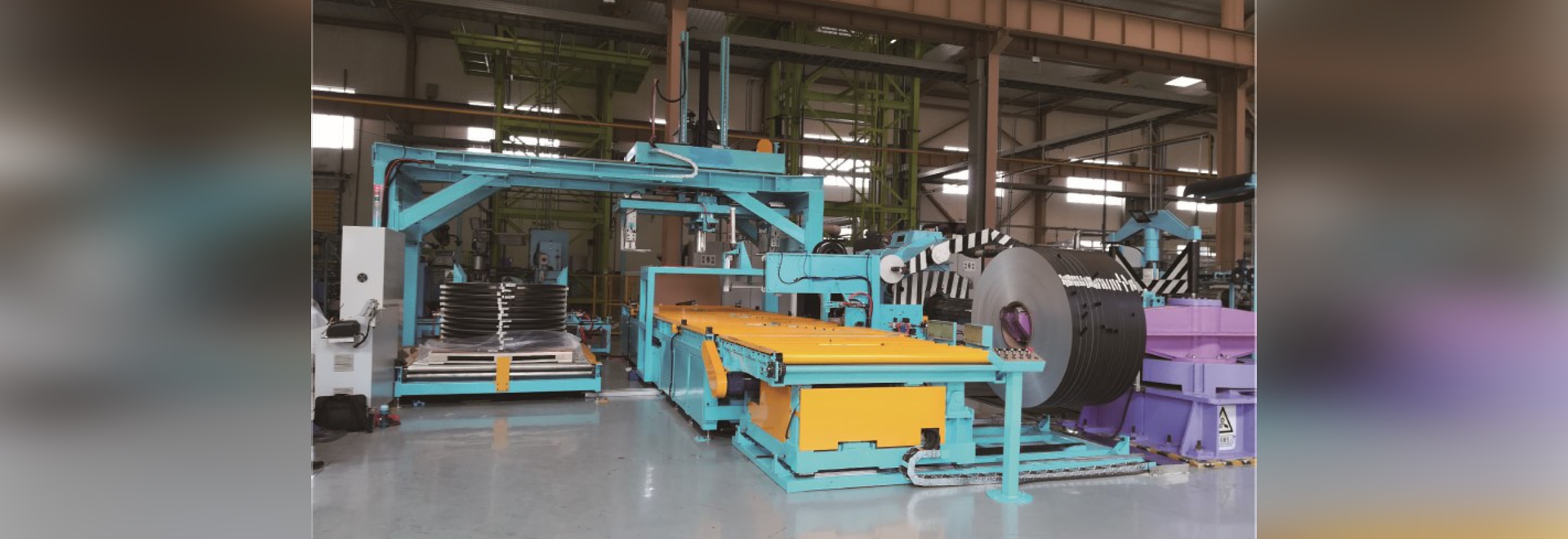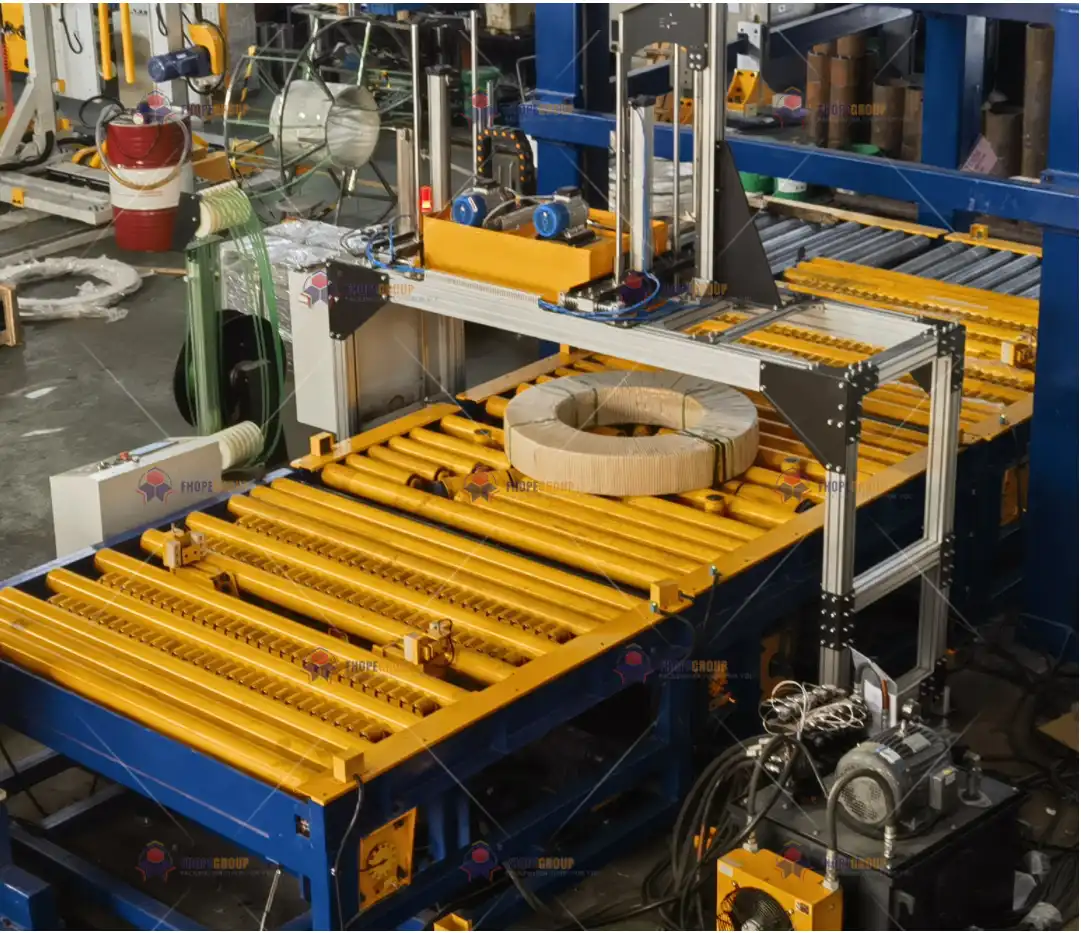Your slitting line is running at full speed, producing perfectly cut coils. But then, you look downstream and see a problem. Coils are piling up. The packaging line has stopped. Again. It’s a familiar story for many steel mill owners. An aging, unreliable wrapping line creates a bottleneck that cripples your entire production efficiency. Every minute of that downtime is a direct hit to your bottom line, causing delays, frustrating your team, and putting customer orders at risk. You know that to hit your targets, you can't afford these unplanned stops. You need a system that doesn't just work, but works consistently. What if the solution lies not in adding more complexity, but in embracing a design philosophy prized by some of the world's best engineers for its incredible reliability?
The coil wrapping line Italian engineers recommend is a fully automated, integrated system built on a foundation of mechanical simplicity and heavy-duty, robust components. This design philosophy prioritizes minimizing potential failure points and ensuring seamless integration with factory-wide systems like your MES. By focusing on durable construction over fragile, over-engineered electronics, it delivers maximum uptime and allows for predictive maintenance, directly addressing the core challenge of unplanned downtime.

This approach sounds solid, but what do terms like "mechanical simplicity" and "full integration" actually mean for your daily operations? As an engineer who has spent my entire career designing, building, and running these exact systems, I’ve learned that the details are what separate a good machine from a great one. It’s the difference between a line that runs and a line that makes you money. Let's break down the core principles that Italian engineers build into their best lines and how you can apply them to solve the challenges you face in your mill.
Why Does an Italian-Engineered Design Prioritize Mechanical Simplicity?
Is your maintenance team constantly troubleshooting complex electrical faults on your packaging line? A single sensor fails, and the entire system grinds to a halt. Finding the root cause takes hours, and in the meantime, production is at a standstill. This is a common frustration I hear from plant managers. They've been sold on "smart" machines that are so full of delicate sensors and complex programming that they become a nightmare to maintain. The constant need for specialized technicians and a large inventory of electronic spare parts drives up your operational costs and makes every shift a gamble.
Italian-engineered designs prioritize mechanical simplicity because it is the most direct path to reliability. By reducing the number of components that can fail—especially sensitive electronics—the design inherently increases machine uptime. A simpler, more robust mechanical system is easier to understand, faster to troubleshoot, and requires less specialized maintenance, making your operation more resilient and predictable.

Deeper Dive: Robustness Over Complexity
When I started as an engineer, I was fascinated by complex automation. But after years of seeing what actually works on the factory floor, I came to appreciate a different kind of elegance: the elegance of simplicity. A machine that performs its function flawlessly for 20 years is a better-engineered product than a "smarter" machine that fails every two months. This is the philosophy at the heart of the best Italian designs. It's a pragmatic focus on what truly delivers value: uninterrupted operation.
The Trade-off: Smarter vs. Stronger
There is a point where adding more "smart" features yields diminishing returns. While sensors and data are crucial for a connected factory, over-engineering the basic mechanical functions with delicate electronics is a common mistake. For example, using a laser sensor for a simple proximity check where a durable mechanical limit switch would suffice adds an unnecessary point of failure. The goal is to use technology where it adds the most value—like in MES integration and predictive analytics—while keeping the core machine functions as mechanically sound as possible.
Key Areas of Mechanical Robustness
A robust design focuses on building strength into the components that do the heavy lifting, day in and day out. Here’s a look at how this philosophy applies to critical parts of a coil wrapping line:
| Component | Standard Design Weakness | Italian-Inspired Robust Solution |
|---|---|---|
| Machine Frame | Lighter gauge steel, bolted construction that can loosen over time. | Heavy-duty, welded, single-piece structural steel frame. This prevents flexing and vibration, extending the life of all moving parts. |
| Conveyor System | Standard-duty chains and smaller sprockets that wear quickly under heavy loads. | Oversized, hardened steel chains and large-diameter sprockets. This reduces stress on the chain and motor, leading to longer life. |
| Wrapping Ring | Lighter ring assembly with standard bearings, prone to vibration and wear. | A solid, cast-metal turning ring with oversized slewing bearings, similar to those used in heavy cranes. This ensures smooth, stable rotation. |
| Hydraulic System | Smaller pumps and valves that run at high pressure, leading to overheating and leaks. | A system with a larger pump and oversized valves that operates at lower pressure. This reduces strain, heat, and the risk of failure. |
This focus on overbuilding the core mechanics means the machine can withstand the harsh environment of a steel mill without constant adjustments and repairs. It’s a foundational element for achieving your goal of 95% uptime.
How Does a Fully Integrated Line Boost Overall Efficiency?
You've invested heavily in a high-speed slitting line. It’s a powerful piece of equipment. But its actual output is limited by the slowest part of your process. If coils are sitting on the floor waiting for a forklift to move them to a separate strapping station, then to a wrapping machine, you have created a massive bottleneck. Each manual touchpoint, each pause between steps, is lost time. Your multi-million dollar slitter is effectively being throttled by an inefficient downstream process. The result is that your overall capacity utilization is far lower than it should be, and your cost per ton creeps up.
A fully integrated line boosts efficiency by creating a seamless, automated workflow from the slitter exit to the final packaged coil. By connecting coil transport, strapping, wrapping, and stacking into a single, continuous system controlled by a central PLC, it eliminates manual handling and idle time. This ensures the packaging process moves at the same pace as your slitting line, maximizing the throughput of your entire operation.

Deeper Dive: From Bottleneck to Continuous Flow
I remember visiting a client in Mexico, a man much like Javier, who had this exact problem. His plant was filled with state-of-the-art production machines, but the space between them was chaotic. Forklifts weaved in and out, coils were staged in random locations, and the packaging area was a constant scramble. We didn't just sell him a wrapping machine; we designed a total solution that connected his processes.
Mapping the Integrated Workflow
An integrated line isn't just one machine. It's a system of components working in harmony. Here’s what that looks like:
- Coil Downender/Tilter: As a slit coil comes off the turnstile, a tilter automatically and safely turns it from eye-to-sky to eye-to-wall orientation, ready for strapping. This eliminates dangerous manual flipping or forklift maneuvers.
- Automated Conveyors: The coil moves smoothly on heavy-duty conveyors to the next station. There is no waiting. The system knows a coil is coming and is ready for it.
- Automatic Strapping Machine: The coil is automatically indexed, and the strapping machine applies radial or through-the-eye straps according to pre-programmed recipes.
- Automatic Wrapping Machine: The strapped coil continues directly into the wrapping station, where it is wrapped with the correct material and number of layers.
- Stacking and Palletizing: After wrapping, the coil is automatically labeled and moved to a stacking station, where it's prepared for storage or shipping.
The Power of Centralized Control and MES Integration
This entire flow is managed by a single Programmable Logic Controller (PLC). This is critical. It allows the system to operate as one cohesive unit. But for a forward-thinking owner like Javier, the real power comes from connecting this PLC to your Manufacturing Execution System (MES). This is a key step in your digital transformation. When integrated, you can:
- Achieve Full Visibility: Your production managers can see the status of the entire packaging line in real-time on their dashboards.
- Enable Data-Driven Decisions: Track key metrics like coils per hour, material consumption, and downtime. This data is essential for identifying areas for improvement and achieving your 8% cost reduction goal.
- Implement Predictive Maintenance: By analyzing data from motor amperage, cycle times, and sensor feedback, your MES can predict when a component is likely to fail, allowing you to schedule maintenance before a breakdown occurs. This is how you move from reactive repairs to proactive uptime management and reach that 95% effective run time.
What Makes a Supplier a True Partner Beyond the Machine?
You’ve likely experienced it before. A supplier is very attentive during the sales process. They make big promises and show impressive brochures. But once the equipment is installed and the final payment is made, they become difficult to reach. When you have a technical problem or need advice on optimizing the machine, you're met with silence or a slow, unhelpful response. This transforms your capital investment from an asset into a liability. You aren't just buying a machine; you are investing in a capability. You need a supplier who is as invested in that capability as you are—a strategic partner.
A supplier becomes a true partner by committing to your success throughout the entire lifecycle of the equipment. This partnership goes far beyond the sale to include collaborative design to meet your specific needs, expert installation and commissioning, responsive long-term technical support, and proactive guidance on future challenges like digital upgrades and environmental compliance. They act as an extension of your own engineering team.

Deeper Dive: The Lifecycle of a Strategic Partnership
I built my own factory on the principle of partnership. When I was an employee, I saw how a "fire-and-forget" sales approach hurt clients. When I started SHJLPACK, I vowed to do it differently. Our relationship with a client doesn't end at shipping; that's when it truly begins. For a business leader like Javier, who thinks in terms of long-term strategy, this is the only model that makes sense.
Stages of a True Partnership
A partnership isn't a transaction; it's a process. It evolves through several key stages:
- Deep Consultation: A partner doesn't start by showing you a catalog. They start by asking questions. What is your current throughput? What are your bottlenecks? What are your five-year goals for this production line? They visit your plant to understand your layout, workflow, and challenges firsthand.
- Collaborative Design: The solution is designed with you, not for you. Your team's input is critical. We work with your engineers and operators to ensure the machine fits your space, integrates with your existing equipment, and is easy for your team to operate and maintain.
- Transparent Manufacturing: You should be welcome to see your machine being built. A good partner provides regular progress updates with photos and videos, giving you confidence in the quality of the build before it ever leaves their factory.
- Expert Installation & Training: The partner's own engineers should be on-site for installation and commissioning. They don't leave until the line is running smoothly and your team is fully trained and comfortable with the operation and basic maintenance.
- Proactive Long-Term Support: This is the most critical stage. A partner provides responsive support when you need it. But they also reach out proactively. They might call to discuss a potential software upgrade, a new wrapping material that could save you money, or a maintenance procedure to extend the life of a component. They provide advice on challenges you mentioned, like meeting new environmental standards or advancing your digital transformation. This is the difference between a supplier and a partner who helps you grow.
My Take: Where Chinese Pragmatism Meets Italian Design?
You appreciate the high-level engineering and reliability associated with top Italian or German brands. It speaks to your own background as an engineer. But as a business owner, you must also conduct a strict feasibility analysis for every investment. The premium price tag for European machinery can sometimes make the return on investment difficult to justify, especially in a market with fluctuating demand and constant cost pressures. On the other hand, you are rightly wary of low-cost alternatives that sacrifice quality and reliability, ultimately costing you more in downtime and repairs. This can feel like an impossible choice.
My take is that you don't have to choose between premium European design and affordable manufacturing. The optimal solution lies in combining the two. At SHJLPACK, we have built our business on this hybrid model: we embrace the core principles of Italian engineering—robustness, simplicity, and integration—and execute them with the efficiency and pragmatism of Chinese manufacturing. This allows us to deliver a high-performance, ultra-reliable solution that also makes sound financial sense.

Deeper Dive: Engineering the Best of Both Worlds
My entire journey in this industry has been about finding this balance. I started on the factory floor, learning what makes a machine fail. I then worked as an engineer, learning how to design them better. When I founded my own factory, I had to learn how to do it all cost-effectively without sacrificing the quality I believe in. This experience taught me that great engineering isn't about geography; it's about philosophy.
It's About Principles, Not Postcodes
The "Italian design" we've been discussing is a set of principles. It's not magic that can only happen in Italy. It's a commitment to:
- Using heavier steel for frames.
- Selecting oversized bearings and motors.
- Prioritizing simple, strong mechanical solutions.
- Writing clean, well-documented PLC code for easy integration.
We have adopted these principles as our own. When we design a line for a client like Javier, we aren't just assembling parts. We are engineering a solution based on these proven philosophies. We source high-quality global components—like Siemens PLCs or SKF bearings—and integrate them into our robust, heavy-duty machine frames.
A Pragmatic Approach to ROI
A pragmatic entrepreneur like Javier understands that the true cost of a machine is not its purchase price. It's the Total Cost of Ownership (TCO) over five or ten years. Here’s how our hybrid approach impacts that calculation:
| Factor | Premium European Line | Standard Low-Cost Line | SHJLPACK Hybrid Approach |
|---|---|---|---|
| Initial Investment | Very High | Low | Moderate |
| Uptime / Reliability | Very High | Low to Medium | Very High |
| Maintenance Costs | High (Specialized Parts/Service) | High (Frequent Repairs) | Low (Durable Parts/Easy Service) |
| 5-Year TCO | Very High | High | Lowest |
This is the core of our value proposition. We provide the uptime and reliability you'd expect from a premium European brand, but with a total cost of ownership that is significantly lower. We give you the engineering excellence you respect and the financial return you require. It's not a compromise; it's a smarter way to invest. This is how I achieved my own financial independence, and it's how I help my clients build more profitable and resilient businesses.
Conclusion
Cutting downtime is about more than just a new machine. It’s about adopting a philosophy of reliability, seamless integration, and true partnership to build a more resilient, efficient, and profitable operation.





